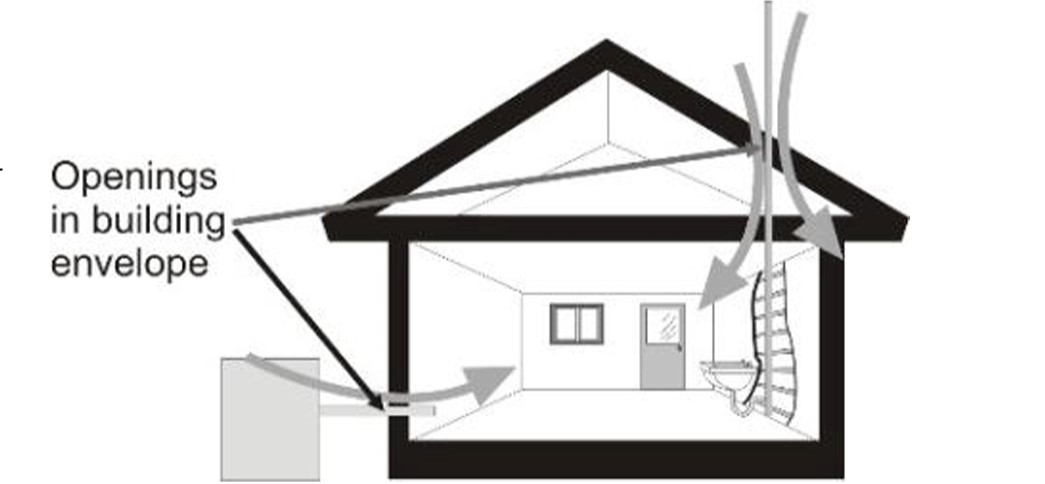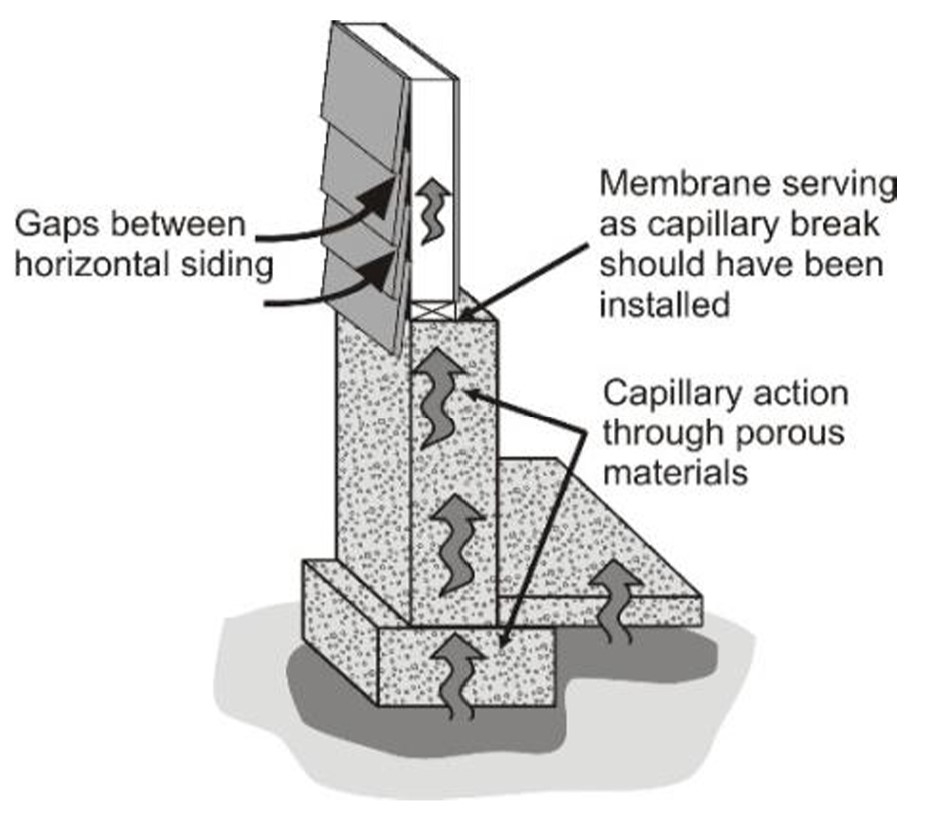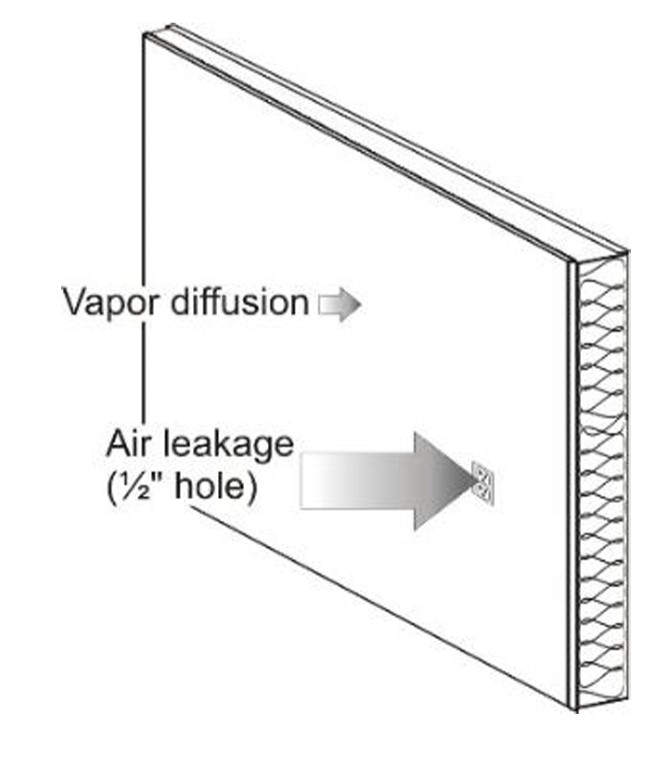ENERGY SERIES: What about Moisture?
ID
2908-9020 (BSE-307NP)
Air is made up of a mixture of gases including oxygen, nitrogen, and carbon dioxide. It also contains water vapor, water in the form of a gas. The temperature of the air determines how much water vapor it can hold: warm air can hold more than cool air. When the air is saturated, it cannot hold any more, and any extra water vapor will condense into liquid form.
The moisture control system includes quality construction to shed water away from the building and its foundation; vapor and air barrier systems that hinder the flow of air infiltration and water vapor; and cooling and heating systems designed to provide comfort throughout the year.
What about relative humidity?
“Relative humidity” is the term used to describe the amount of water vapor currently in the air, compared to the amount it could hold if it were saturated; this is dependent on the air’s temperature. At 100% relative humidity, the air is saturated and water vapor will condense into a liquid; the temperature at which this happens is called the dew point. Preventing condensation involves either reducing the relative humidity of the air or increasing the temperature of surfaces exposed to the air.
Why care about relative humidity?
People respond dramatically to changes in relative humidity:
At lower relative humidity, we feel cooler as moisture evaporates more readily from our skin.
At higher levels, we may feel uncomfortable, especially at temperatures above 78ºF.
People are most comfortable at 35% to 55% relative humidity.
Dry air can often aggravate respiratory problems.
Other important effects of humidity:
Dust mites prosper at over 50% relative humidity.
Fungi (molds) grow in air over 60% relative humidity.
Wood decays when the relative humidity is near or at 100%.
High levels of moisture, along with poor housekeeping, also contribute to poor indoor air quality by creating a good environment for roaches.
How does moisture get in my house?
Buildings should be designed and built to provide comfortable and healthy levels of relative humidity. They should also prevent both liquid water and water vapor from migrating through building components.

There are four primary ways that moisture can get into buildings: 1) bulk moisture transport, 2) capillary action, 3) air infiltration, and 4) vapor diffusion. Each method must be controlled to preserve occupants’ comfort, health, and building integrity. Looking at each in greater detail will help explain their importance.
Bulk moisture transport (Figure 1) is the flow of moisture—primarily rain—through holes, cracks, or gaps. Such openings can result from poor flashing— the materials used, as well as the process of, making roof intersections, window openings, and other places on the outside of a structure watertight. Openings can also result from inadequate drainage, and poor quality weather-stripping or caulking around joints in the building exterior (such as windows and doors).
This is the most important of the four modes of moisture migration because bulk moisture leaks represent pathways for liquid water to immediately move into building cavities; the other methods generally take longer to create a significant problem. Quality construction with durable materials will prevent bulk moisture transport.

The wicking of water— generally rain or groundwater—through porous materials or between small cracks is called capillary action (Figure 2). Common causes include water seeping between overlapping pieces of exterior siding; water drawn upward through pores or cracks in concrete slabs; and water migrating from crawl spaces into attics through foundation walls and wall framing. Solve the potential problem during construction by completely sealing pores or gaps, increasing the size of the gaps in some cases (usually to a minimum of 1/8 inch), or installing a waterproof, vapor retarder material (under slab) to form a capillary break.

Unsealed penetrations and joints between conditioned and unconditioned areas allow air containing water vapor to flow into enclosed areas. This air infiltration (Figure 3) can bring 50 to 100 times more moisture into wall cavities than vapor diffusion (discussed in the next paragraph). Causes include moisture-laden air leaking through holes, cracks, and other leaks between:
Interior air and enclosed wall cavities
Interior air and attics
Exterior air and interior air, adding humidity to interior air in summer
Crawl spaces and interior air
Solve the potential problem by creating an air barrier system. For more information on air barriers, please visit: https://www.buildingscience.com/documents/reports/rr-0403-air-barriers/view
Water vapor in air can also move through permeable materials; it tends to move from an area of higher concentration of water vapor to an area of lower concentration. This is called vapor diffusion. Causes include exterior moisture moving into the building in summer, interior moisture (showers, cooking, etc.) permeating wall and ceiling finish materials, and moist crawl space air migrating into the building. The amount of moisture diffused is usually relatively small unless driven by high vapor pressure and heat such as rain-saturated walls heated by the sun on a hot, humid day.
Vapor retarders (some of which are considered vapor barriers) are materials used to reduce or stop water vapor diffusion—a common building practice in northern climates. Building specialists indicate vapor retarders should not be used within walls or ceilings in hot, humid climates (only under the slab). Do not confuse vapor retarders with air barriers; not all air flow retarders are vapor diffusion retarders.
Can moisture defy gravity?
Water always flows downhill, right? Wrong! Under the proper conditions, it can defy gravity. When factors like flow rate, surface tension, and even air movement are right, water can enter horizontal or vertical building surface gaps and move through them in any direction, including upward. Similarly, capillary action can cause “wicking” of water into porous materials like wood, brick, and concrete, again in any direction, regardless of gravity.
What about choosing building materials?
The rated characteristics of building materials (strength, permeability, R-value, expected longevity, etc.) are based upon a given set of conditions. When conditions change, characteristics may change, too. These changes may be good or bad.
Building material deterioration is largely a function of exposure to water, high humidity levels, heat, and ultraviolet light from the sun. Water is by far the biggest factor. Moisture- related damage occurs when the rate of wetting exceeds the rate of drying, so that the water storage capacity of a material is exceeded. For most structural materials, such as masonry, solid wood, and metal, repeated wetting is not a problem, if they dry quickly enough. But engineered woods, drywall, and other fabricated structural materials have varying abilities to withstand wetting; refer to manufacturers’ specifications and grades.
Deterioration begins after the accumulated moisture exceeds a material’s water storage capacity. The water storage capacity provides a kind of buffer, or cushion of safety, to allow time for drying. Deterioration can also be caused by fungi, etc. growing on damp surfaces under conditions of high, but not complete, saturation. The organisms themselves break down the material, accelerating the destruction of the building.
Never assume that outer building parts such as siding, roofing, and “sealed” windows are waterproof. Virtually all of these building parts can leak sooner or later, and leak in varying amounts. Materials expand and contract at different rates, causing movement, which can lead to separation, gaps, and cracks.
References and Resources
Georgia Environmental Facilities Authority. 1999. A Builder’s Guide to Energy Efficient Homes in Georgia. Division of Energy Resources, Atlanta, GA
http://dlg.galileo.usg.edu/ggpd/docs/1999/ga/e480_pe5/m1/1999/b8/elec_p_btext.con/1.pdf
U.S. Department of Energy. 2000. Weather- Resistive Barriers. Office of Building Technology, State and Community Programs, Energy Efficiency and Renewable Energy. https://www1.eere.energy.gov/buildings/publications/pdfs/building_america/28600.pdf
University of Florida. 2009. Energy Efficient Building Construction in Florida. Florida Cooperative Extension Service, Institute of Food and Agricultural Sciences, Gainesville, FL. SP 267.
Developed as part of the NASULGC/DOE Building Science Community of Practice. The factsheet editors are: Robert "Bobby" Grisso, Ph. D., Extension Engineer, Biological Systems Engineering; Martha A. Walker, Ph.D, Community Viability Specialist, Central District; Philip Agee, Ph. D., Assistant Professor, Department of Building Construction, and John Ignosh, Extension Specialist, Biological Systems Engineering, Virginia Tech.
DISCLAIMER – This document is intended to give the reader only general factual information current at the time of publication. It is not a substitute for professional advice and should not be used for guidance or decisions related to a specific design or construction project. This document is not intended to reflect the opinion of any of the entities, agencies or organizations identified in the materials and, if any opinions appear, are those of the individual author and should not be relied upon in any event.
Virginia Cooperative Extension materials are available for public use, reprint, or citation without further permission, provided the use includes credit to the author and to Virginia Cooperative Extension, Virginia Tech, and Virginia State University.
Virginia Cooperative Extension is a partnership of Virginia Tech, Virginia State University, the U.S. Department of Agriculture (USDA), and local governments, and is an equal opportunity employer. For the full non-discrimination statement, please visit ext.vt.edu/accessibility.
Publication Date
February 24, 2020



